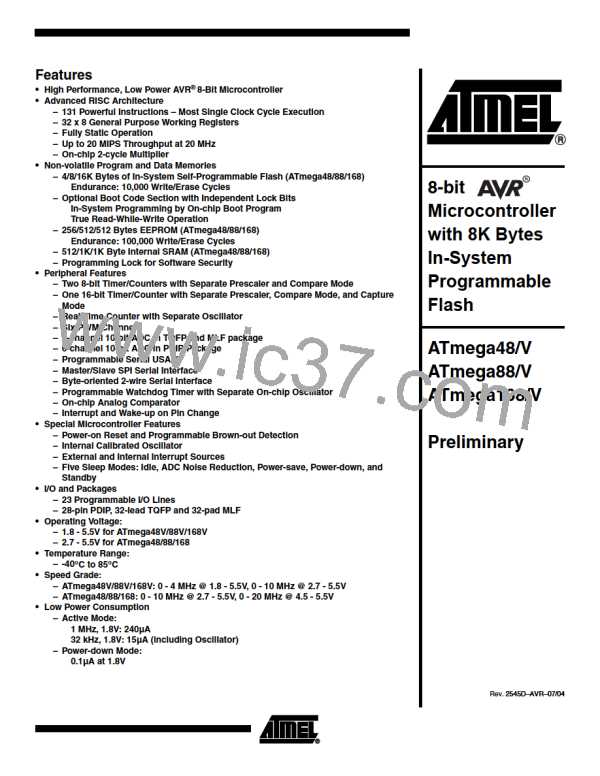ATmega48/88/168
TWI (Slave) Address Mask
Register – TWAMR
Bit
7
6
5
4
TWAM[6:0]
R/W
3
2
1
0
–
TWAMR
Read/Write
Initial Value
R/W
0
R/W
0
R/W
0
R/W
0
R/W
0
R/W
0
R
0
0
• Bits 7..1 – TWAM: TWI Address Mask
The TWAMR can be loaded with a 7-bit Salve Address mask. Each of the bits in
TWAMR can mask (disable) the corresponding address bits in the TWI Address Regis-
ter (TWAR). If the mask bit is set to one then the address match logic ignores the
compare between the incoming address bit and the corresponding bit in TWAR. Figure
87 shown the address match logic in detail.
Figure 87. TWI Address Match Logic, Block Diagram
TWAR0
Address
Match
Address
Bit 0
TWAMR0
Address Bit Comparator 0
Address Bit Comparator 6..1
• Bit 0 – Res: Reserved Bit
This bit is an unused bit in the ATmega48/88/168, and will always read as zero.
Using the TWI
The AVR TWI is byte-oriented and interrupt based. Interrupts are issued after all bus
events, like reception of a byte or transmission of a START condition. Because the TWI
is interrupt-based, the application software is free to carry on other operations during a
TWI byte transfer. Note that the TWI Interrupt Enable (TWIE) bit in TWCR together with
the Global Interrupt Enable bit in SREG allow the application to decide whether or not
assertion of the TWINT Flag should generate an interrupt request. If the TWIE bit is
cleared, the application must poll the TWINT Flag in order to detect actions on the TWI
bus.
When the TWINT Flag is asserted, the TWI has finished an operation and awaits appli-
cation response. In this case, the TWI Status Register (TWSR) contains a value
indicating the current state of the TWI bus. The application software can then decide
how the TWI should behave in the next TWI bus cycle by manipulating the TWCR and
TWDR Registers.
Figure 88 is a simple example of how the application can interface to the TWI hardware.
In this example, a Master wishes to transmit a single data byte to a Slave. This descrip-
tion is quite abstract, a more detailed explanation follows later in this section. A simple
code example implementing the desired behavior is also presented.
209
2545D–AVR–07/04

 ATMEL [ ATMEL ]
ATMEL [ ATMEL ]